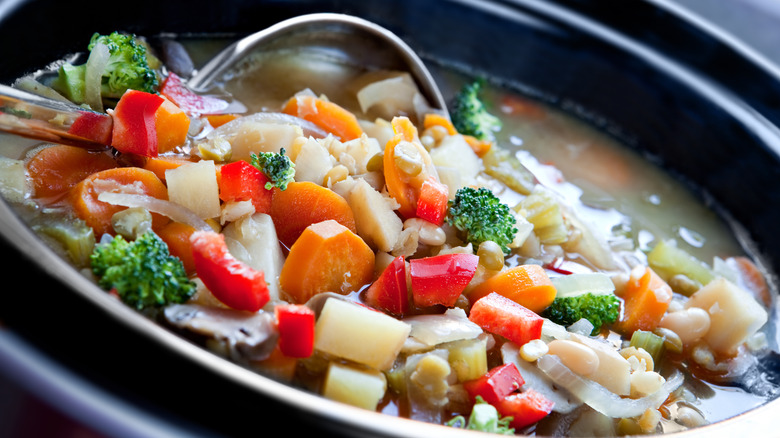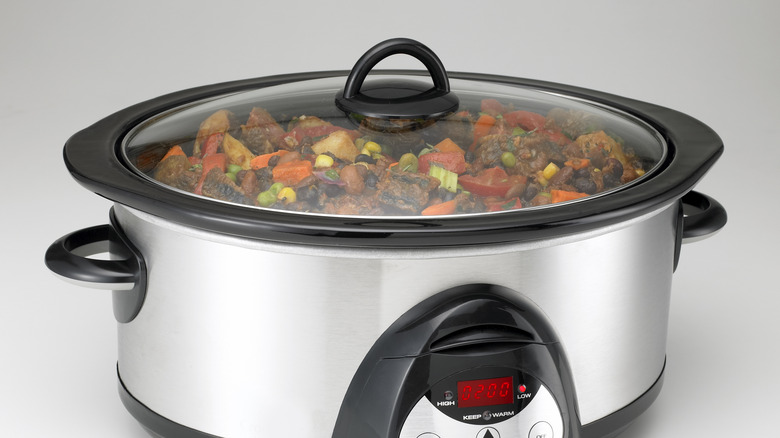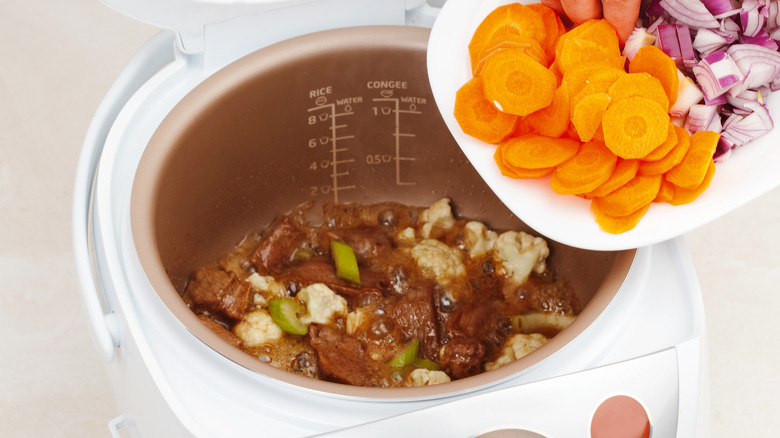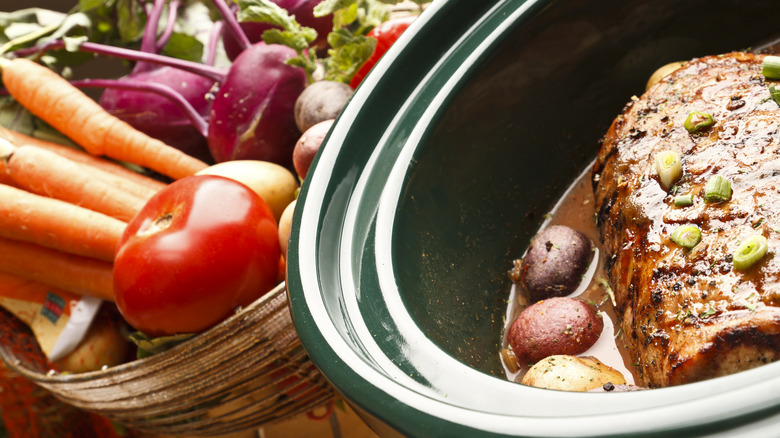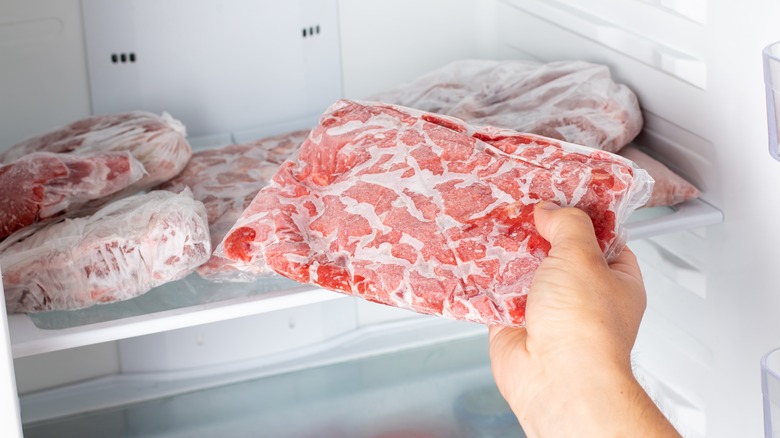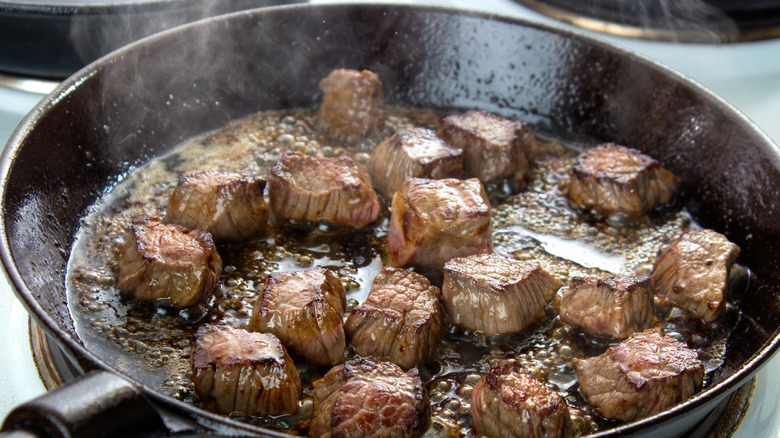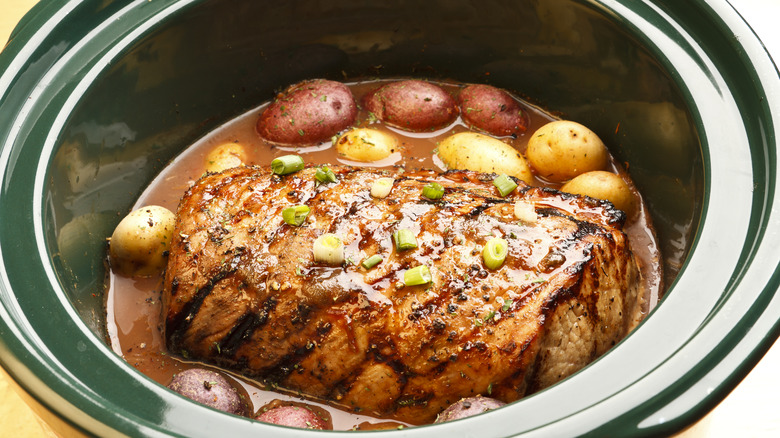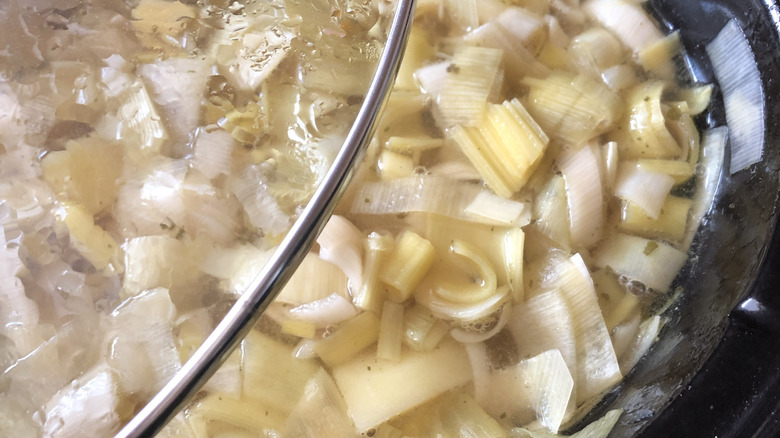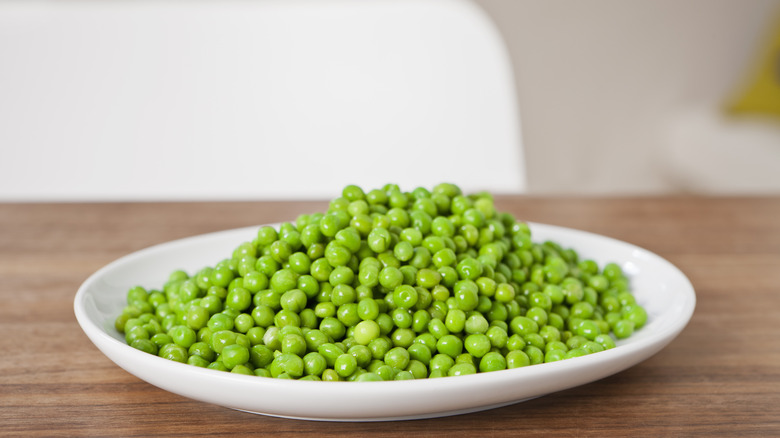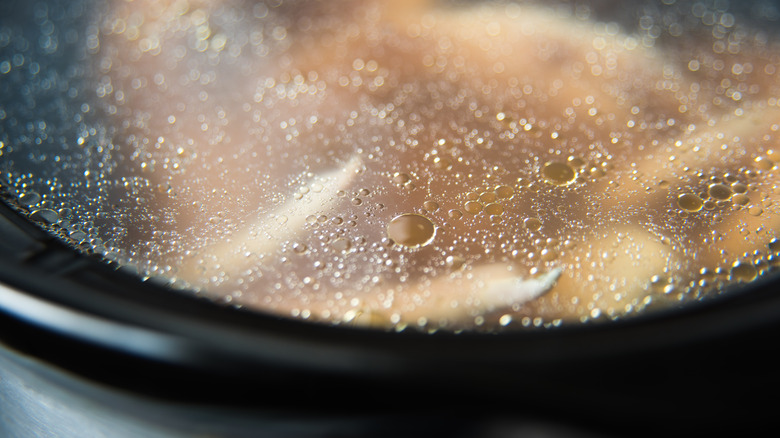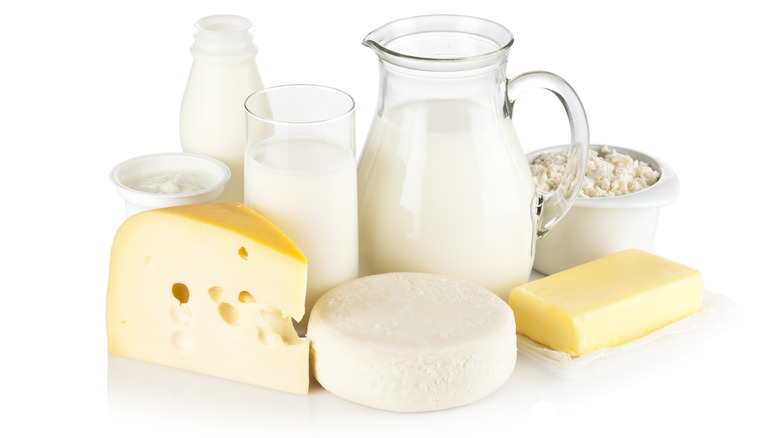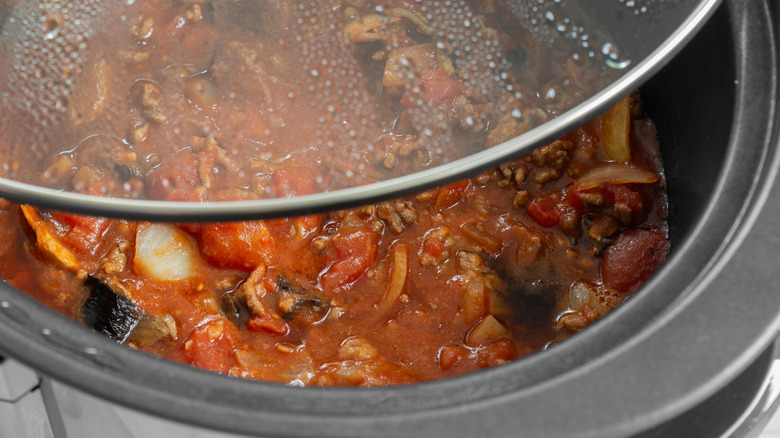11 Tips For Making Soup In The Slow Cooker
Slow cookers make getting a meal on the table a breeze. They are a lifesaver for busy cooks, and, with a little planning, they can take the stress out of the age-old question — what's for dinner? No more last-minute scrambles around the kitchen searching for something to serve. With a slow cooker, you only have to load it up with your prepped ingredients, go about your day, and, hours later, you're treated to the fruits of your minimal labor, a flavorful meal simmered gently for hours. It's mealtime magic at its best, and there's no better food fit for a slow cooker than homemade soup.
Slow cookers can transform a few simple ingredients into the most delicious soups by simmering them for hours. This low and slow cooking allows the flavors to mingle, creating rich, flavorful soups perfect for chilly days, nights, or any day you want to enjoy a bowl full of goodness. But there's more to making stellar soups in the slow cooker than tossing in your ingredients and hoping for the best. Preparing soup from scratch is an art, and these tips for making soups in the slow cooker will upgrade your soup-making skills and help put your best soup forward.
Use the right size slow cooker
Slow cookers are not a one-size-fits-all-all appliance. They are available in various sizes to cook individual servings from 1.5 quarts to 10 quarts. Each serves a purpose, and choosing the right size slow cooker to fit your cooking needs is essential.
A large slow cooker is perfect for preparing food in large batches. You can feed a crowd or freeze portions to enjoy later as part of a slow cooker meal prep plan. The smallest slow cookers can be used to prepare an individual serving if you're a party of one or to make appetizers or dips. Most kitchens will benefit from a mid-sized slow cooker, 4 to 6 quarts, that can prepare recipes serving six to eight people.
The amount of food in a slow cooker affects the time it takes to cook, so it's essential to use the correct size. The more food is added to a slow cooker, the longer it will take that food to cook. An overfilled slow cooker may not cook evenly or thoroughly, and an under-filled slow cooker can cause your food to cook faster than planned. Your slow cooker should only be filled to about ¾ of its capacity for best results.
Preheat your slow cooker
Preheating your oven before baking a cake or roasting a chicken is a no-brainer. We even heat our pans before we cook food on the stovetop. Preheating your slow cooker should also be a regular part of your cooking routine: It's an often overlooked step that can significantly impact your slow cooker recipes.
Many slow cooker recipes recommend searing protein and even vegetables before adding them to the slow cooker in order to brown them and give them the caramelized flavor we all love. Adding that browned food to a cold slow cooker can have a negative effect in many ways. First, adding warm, partially cooked food in a slow cooker, especially meats and poultry, can be dangerous.
Adding warm food to a cold slow cooker leaves the food at an unsafe temperature for longer. Bacteria can reproduce rapidly between 40 F and 140 F. When warm food is added to a cold slow cooker, it can linger in this dangerous temperature range for longer. You can reduce this risk by preheating your slow cooker for 20 minutes or up to one hour. Preheating your slow cooker allows for continuous cooking of any food added. A cold slow cooker temporarily interrupts the cooking process. The hot food cools while it waits for the slow cooker to reach peak temperature, extending its time in the unsafe temperature zone where bacteria can flourish.
Choose the right cut of meat
If you're using your slow cooker to make soups with meat, selecting the right cut of meat is imperative for the best results. Slow cookers can turn the toughest cuts of meat into moist morsels of fork-tender goodness. Cooking the meat for an extended period in a moist environment created by broth, wine, or whatever flavorful cooking liquid you choose breaks down the collagen in the meat. This gives the meat abundant flavor and a silky texture.
Fortunately, these tough cuts are also the least expensive, making it possible to feed a large family cheaply by choosing the right meat or poultry for your soup. Not only are leaner meats and poultry usually more expensive, but they can dry out after hours of slow cooking. Choose cuts like chuck roast, rump roast, ground chuck, short ribs, pork butt, shoulder, bottom rounds, brisket, and lamb shanks for the most tender and savory outcomes.
Chopped boneless, skinless chicken breasts are a popular choice for numerous slow cooker soup recipes, but they are so lean it's easy to dry them out with a long cooking time. Opt for boneless, skinless chicken thighs for a more tender option.
Avoid frozen meat and poultry
Convenience is a big reason many cooks choose the slow cooker as their cooking method of choice. Pull your ingredients out of the fridge, prep them, and into the slow cooker they go. Slow cookers save time and help busy cooks take the stress out of dinner time. This convenience shouldn't apply to frozen meat and poultry.
Some slow cooker recipes call for frozen meat or poultry, directing cooks to add them to their slow cookers straight from the freezer. As tempting as adding frozen meat and poultry to your slow cooker might be, it's not the best way to proceed, and it could be dangerous from a food safety perspective.
Adding frozen meat or poultry to a slow cooker can extend the time it takes for the food to reach a food-safe temperature, and the longer food lingers in, giving any bacteria present ideal conditions to grow. The USDA strongly recommends that slow cooker users thaw frozen meat and poultry in the fridge before adding it to the slow cooker. However, if you must use frozen meat and poultry, extend your cooking time to compensate and verify that your meat has reached an internal temperature of at least 165 F before digging in.
Sear meats before adding to the slow cooker
Searing or browning meat before adding it to the slow cooker takes a little extra time, but it's worth the effort. The caramelization that comes with searing boosts flavor and seals in moisture. It's a flavorful building block that produces delicious results and one that you should not skip. Your dish will likely still end up tasty, but you'll miss the more intense, multi-layered flavor that comes with browning.
If you're using ground meat, it should always be browned before adding it to a slow cooker. Dropping a large chunk of raw ground meat or poultry into your slow cooker is less than ideal. Browning the meat gives it more flavor and allows you to break it up as it sears. You'll end up with the ground meat evenly distributed throughout your soup instead of a solid mass at the bottom of the slow cooker.
To save time, you can brown ground meat ahead of time and freeze it in 1-pound portions. When you want to use it, thaw it overnight in the fridge, and it's ready for the slow cooker in the morning. Lightly dredge your meat and poultry in flour before you brown it to thicken your soup as it cooks.
Layer your ingredients in the right order
Making soup in the slow cooker is easy, but there are simple steps you can take to ensure your soups turn out well. Layering is one of those steps. It might seem inconsequential, but adding foods in the correct order can significantly improve your slow cooker soups.
The way you layer your ingredients in your slow cooker can make or break a recipe. Where ingredients are placed in the slow cooker can determine how well they cook. The work begins before you start cooking, with your prep work. Cut your vegetables, meat, and poultry into pieces about the same size so they'll cook in about the same amount of time.
Place dense root vegetables like carrots, turnips, parsnips, and potatoes on the bottom of your slow cooker along with your meat. These items will take longer to cook and will benefit from direct contact with the high heat at the bottom of the slow cooker. Add hearty grains like bulgur or barley to your soup next, followed by tender vegetables like green beans, broccoli, or zucchini. Last but not least, add your cooking liquid of choice.
Add pasta, grains, and fresh herbs at the end
While the slow cooker's long, slow cooking time works miracles on tough cuts of meat, it's not the best cooking method for many ingredients. Adding these items to your slow cooker at the wrong time can alter the taste and texture of your finished soup.
If you're adding pasta to your slow cooker soups, add them in the last 30 to 40 minutes of cooking. Any longer, and it will overcook, leaving you with a soup full of mushy or gummy overcooked pasta. Grains like brown rice, quinoa, and wheat berries are hearty enough to withstand long slow cooker sessions, but white rice, especially if you're using instant rice, should be added in the last 30 minutes of cooking.
Fresh herbs give slow cooker soups and other dishes a brightness that enhances their overall flavor. Add them to your slow cooker at the end of the cooking process to make the most of that flavor. Most fresh herbs are delicate and can't withstand being cooked for several hours. There are a few exceptions to this rule. Firmer herbs like rosemary and thyme can be added to your slow cooker with other soup ingredients and slow-cooked for hours without diminishing flavor.
Skip vegetables with quick cooking times
Slow cookers are known for long cooking times, and while this is a great way to cook certain cuts of meats and root vegetables, it doesn't work well for some foods. Delicate vegetables with quick cooking times do not fare well in the slow cooker. They end up overcooked, soft, or even mushy with little flavor.
If your recipe won't be the same without these vegetables, be strategic when adding them to your slow cooker. You can get them in the mix at the tail end of cooking so they won't overcook and are at their best when served. For fast-cooking vegetables like asparagus and peas, adding them to your slow cooker in the last 10 to 15 minutes of cooking is the way to go. Leafy greens like spinach, bok choy, and kale, all excellent additions to soups, will wilt and develop an off texture if cooked too long. They should also be added in the last 10 to 15 minutes of your soup's cooking time. Many slow-cooker soup recipes call for frozen vegetables, which also have a relatively short cooking time. You'll want to add these at the end of cooking, as well, to give them enough time to thaw and heat through but not overcook.
Use less liquid than a stovetop recipe
Flavorful liquids are the hallmark of slow cooker soup recipes. Whether you're cooking with chicken stock, beef stock, vegetable broth, or wine, choosing the right liquid is key to your recipe's success. That's especially true with slow cooker soups. If you want to convert a stovetop soup recipe to prepare in your slow cooker, you'll need to adjust the amount of liquid you use.
Slow cookers cook food through a combination of direct heat and steam. Once the lid's in place, the steam is trapped inside the slow cooker, and while it helps tenderize any protein in the slow cooker, it also condenses on the slow cooker's lid. Without the ability to evaporate, that excess liquid collects on the slow cooker lid and drips back into the soup. To compensate for this additional liquid, use less liquid in your slow cooker than in a stovetop soup recipe.
If you're worried about adding too much or too little liquid to your slow cooker, place all of your soup ingredients, except your liquid, in the slow cooker. Then add the liquid, enough to cover the vegetables by about ½ inch.
Don't add dairy
Dairy products like milk and heavy cream give soups a wonderful creaminess. They're typically added to soups at the end of cooking, so they have just enough to blend with the other flavors and impart their trademark creaminess. Most soup recipes come with a warning, reminding cooks not to cook soups at a high temperature after adding dairy products because when they get too hot or are cooked too long, they separate or curdle. The result is soups with an oily or grainy texture and off coloring.
Using dairy products in slow cooker soups is no different. If you have to use dairy products in your slow cooker soups, stir them in gently at the end of the cooking process to keep them from separating. If you add cheese to your soup, add it once the soup is fully cooked or directly to your bowl when serving. This technique will give you all the benefits of using dairy products in your soup without ruining the texture or taste of your soup.
Skip removing the lid
Most recipes, no matter the cooking method, encourage cooks to periodically check their food for doneness. This is standard operating procedure for everything from cakes and cookies to meat, poultry, and vegetables. The idea is to ensure cooking goes as planned and you're not over or undercooking your dishes. Slow cookers are the exception to this rule. When using a slow cooker, it's best to adopt a hands-off attitude.
Slow cookers lock in heat and steam to cook food slowly for hours. It's the reason we love them and the food they produce. This low and slow-method gives us the rich flavors and melt-in-your-mouth texture we love. Checking slow cooker dishes for doneness requires removing the lid from the slow cooker, which is a huge no-no.
When you remove the slow cooker lid, you're allowing the heat and steam to escape. This lowers the temperature inside the slow cooker and interrupts the cooking process. Changes in temperature can lead to soups that are cooked unevenly or undercooked. This is especially dangerous if you're preparing a soup with meat or poultry. Removing the lid also extends your cooking time. Removing the lid of your slow cooker even once can lower the cooking temperature by 10 to 15 degrees and increase your cooking time by 30 minutes.
